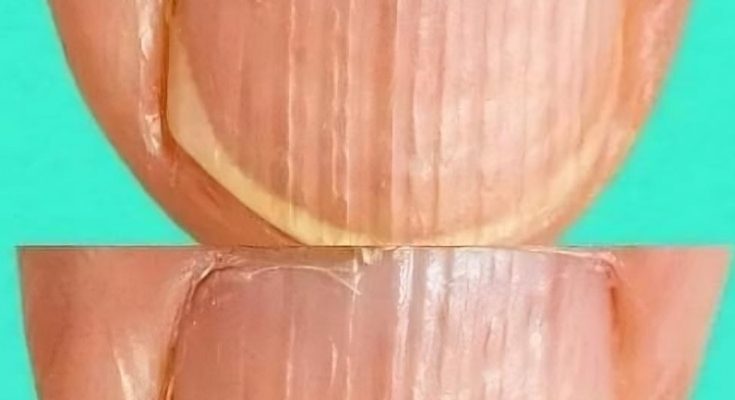Our nails often serve as tiny windows into our overall health. While a manicure can cover up surface imperfections, it can’t mask the health-related signals your nails might be sending. Changes in nail color, texture, and strength can reveal underlying issues with vital organs such as the heart, liver, or lungs. In this article, we’ll explore what different nail characteristics can indicate about your health and when it’s time to seek medical advice.
Nail Stripes and Their Meanings

Your nails can develop various types of stripes or ridges, and each can hold different meanings. Here are some common types of nail stripes and the health issues they might signify.
Vertical Stripes on Nails
Vertical stripes, or longitudinal ridges, are lines that extend from the cuticle to the tip of the nail. These types of stripes are common and generally harmless, especially if they appear gradually with age. As we grow older, vertical ridges may become more pronounced due to natural aging processes.
However, if vertical stripes appear suddenly or seem to deepen, it could indicate certain nutritional deficiencies. A lack of iron, magnesium, or vitamin B12, for example, may contribute to these ridges. If vertical stripes appear abruptly or seem more prominent, it may be worth discussing potential health issues such as anemia or thyroid imbalances with a healthcare provider.
Horizontal Stripes and Their Health Implications
Horizontal stripes or indentations, often called Beau’s lines, can signal more specific health problems. These grooves or lines may appear following periods of high physical stress or serious illness, as the body temporarily halts nail growth during times of intense strain.
Beau’s lines are sometimes linked to medical conditions such as respiratory disorders, heart attacks, malnutrition, or severe infections like pneumonia. According to the National Center for Biotechnology Information (NCBI), these lines may indicate sudden health events, especially if they appear on all nails. In rare cases, conditions like Kawasaki disease, syphilis, or hypoparathyroidism may be associated with these nail changes. If you notice horizontal ridges on multiple nails, consider seeing a healthcare professional for further evaluation.
White Stripes: Muehrcke’s Lines

White horizontal lines that run across the nail, known as Muehrcke’s lines, can sometimes indicate liver or kidney issues. These lines are unique in that they don’t indent the nail surface and often appear on multiple nails simultaneously. When pressure is applied to the nail, these lines may temporarily disappear.
Typically, Muehrcke’s lines are associated with low levels of blood protein, particularly albumin, and can be seen in individuals with chronic liver diseases or those suffering from malnutrition. If these white stripes are present on multiple nails, it may indicate liver or renal issues, and consulting a medical professional is advised.
The Connection Between Diet and Nail Health
A balanced diet plays a crucial role in the appearance and health of your nails. Deficiencies in specific nutrients can lead to brittle, weak, or peeling nails, often indicating an imbalance in your daily nutrition.

According to Dr. Sara Norris, a naturopathic doctor based in Los Angeles, poor nail health often reflects poor nutritional intake or digestive issues. “Brittle, weak, and peeling nails are the most common concerns I see in my practice, and these symptoms are often more the result of a poor diet than systemic disease,” explains Dr. Norris.
To improve nail health, focus on incorporating a variety of nutrients into your diet. Essential vitamins and minerals, such as biotin, vitamin E, iron, and zinc, can contribute to stronger, healthier nails over time.
Nail Texture and Health Concerns
Beyond stripes, other changes in nail texture can be indicative of underlying health conditions. Here are some common texture changes and what they might mean for your health.
Rippled or Pitted Nails
Nail surfaces that appear rippled or pitted may be linked to skin conditions such as psoriasis or eczema. In some cases, rippling can also indicate inflammatory arthritis or other autoimmune conditions. Buffing your nails and moisturizing regularly can help with mild texture issues, but if ripples persist or worsen, it’s worth consulting a healthcare professional for a more thorough assessment.
Brittle or Splitting Nails
Brittle or splitting nails may indicate dehydration or a lack of nutrients. This is a common issue, especially for those who frequently expose their hands to water or harsh chemicals. Maintaining hydration and applying cuticle oil can improve the strength and flexibility of nails. However, if brittleness persists, it may be related to more serious conditions such as hypothyroidism or iron deficiency anemia.
Color Changes and What They Indicate
Nail color changes are often some of the most noticeable signs of health issues. Discoloration in the nails may point to a range of underlying conditions.
Yellow Nails
Yellow nails can be the result of frequent nail polish use, but if the discoloration is persistent, it may signal a fungal infection or respiratory condition. Yellow nail syndrome, though rare, is associated with conditions affecting the respiratory and lymphatic systems. In such cases, nails may become thickened, and the cuticles may retract. Medical intervention is often required if yellowing persists without improvement.
Pale or White Nails
Pale nails can indicate anemia, especially when accompanied by other symptoms like fatigue and dizziness. White nails may also be linked to liver issues such as hepatitis or cirrhosis. If the nail beds are white and the surrounding skin is dark, it could be a sign of more serious health conditions. Checking in with a healthcare provider can help address the root cause of nail paleness.
Blue or Purple Nails
Bluish or purple-tinted nails may suggest low oxygen levels in the blood. This is sometimes seen in individuals with respiratory conditions such as asthma or chronic obstructive pulmonary disease (COPD). Other potential causes include issues with circulation or even Raynaud’s disease, where blood flow is temporarily restricted. If you notice a bluish tint in your nails, seeking medical attention is crucial to address potential circulation or respiratory issues.
When to Seek Medical Help
While some nail changes are harmless and related to aging or minor lifestyle factors, others may signal underlying health problems. If you observe any of the following, it’s best to consult a healthcare professional:
- Persistent discoloration (yellow, blue, or white nails)
- Unexplained nail ridges or lines on multiple nails
- Noticeable texture changes (ridges, pits, or brittleness) that don’t improve with lifestyle changes
- Swelling, pain, or redness around the nails
Nail health can often act as an early warning system for your body, so paying attention to changes can help you detect potential issues before they escalate.
Conclusion: Listen to What Your Nails Are Telling You
From innocuous signs of aging to potential markers of serious health conditions, your nails can reveal a lot about your overall wellness. Often, these changes are harmless and can be improved with simple dietary adjustments or better nail care. However, certain patterns, colors, or textures can act as reliable indicators of underlying health concerns. By staying observant and addressing changes as they arise, you can take proactive steps in maintaining both your nail health and your overall well-being. Remember, sometimes the smallest details can speak volumes about your health—listen to what your nails are telling you.



